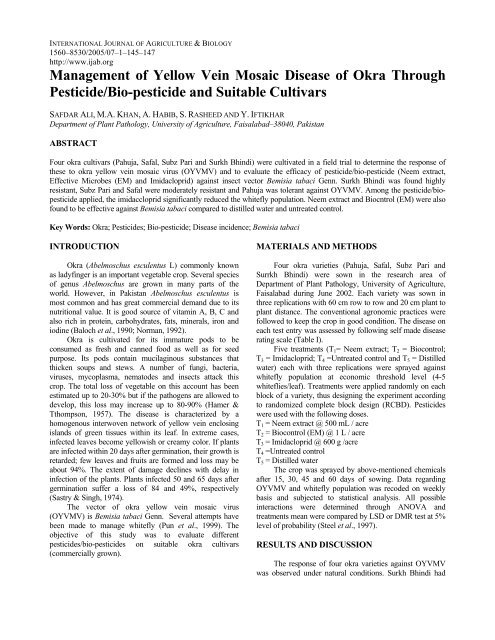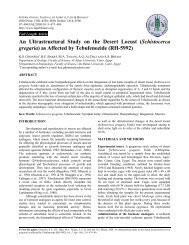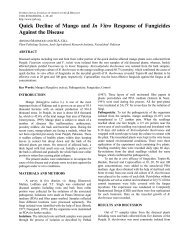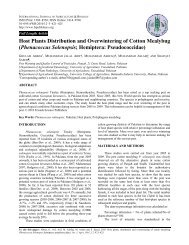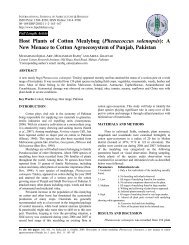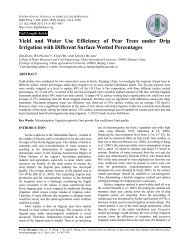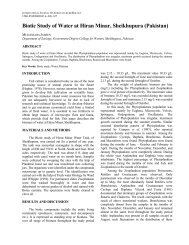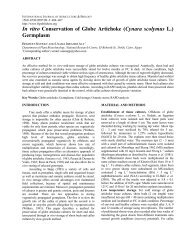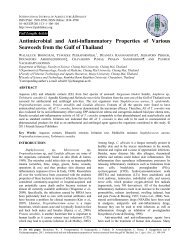Management of Yellow Vein Mosaic Disease of ... - Fspublishers.org
Management of Yellow Vein Mosaic Disease of ... - Fspublishers.org
Management of Yellow Vein Mosaic Disease of ... - Fspublishers.org
Create successful ePaper yourself
Turn your PDF publications into a flip-book with our unique Google optimized e-Paper software.
INTERNATIONAL JOURNAL OF AGRICULTURE & BIOLOGY<br />
1560–8530/2005/07–1–145–147<br />
http://www.ijab.<strong>org</strong><br />
<strong>Management</strong> <strong>of</strong> <strong>Yellow</strong> <strong>Vein</strong> <strong>Mosaic</strong> <strong>Disease</strong> <strong>of</strong> Okra Through<br />
Pesticide/Bio-pesticide and Suitable Cultivars<br />
SAFDAR ALI, M.A. KHAN, A. HABIB, S. RASHEED AND Y. IFTIKHAR<br />
Department <strong>of</strong> Plant Pathology, University <strong>of</strong> Agriculture, Faisalabad–38040, Pakistan<br />
ABSTRACT<br />
Four okra cultivars (Pahuja, Safal, Subz Pari and Surkh Bhindi) were cultivated in a field trial to determine the response <strong>of</strong><br />
these to okra yellow vein mosaic virus (OYVMV) and to evaluate the efficacy <strong>of</strong> pesticide/bio-pesticide (Neem extract,<br />
Effective Microbes (EM) and Imidacloprid) against insect vector Bemisia tabaci Genn. Surkh Bhindi was found highly<br />
resistant, Subz Pari and Safal were moderately resistant and Pahuja was tolerant against OYVMV. Among the pesticide/biopesticide<br />
applied, the imidaccloprid significantly reduced the whitefly population. Neem extract and Biocntrol (EM) were also<br />
found to be effective against Bemisia tabaci compared to distilled water and untreated control.<br />
Key Words: Okra; Pesticides; Bio-pesticide; <strong>Disease</strong> incidence; Bemisia tabaci<br />
INTRODUCTION<br />
Okra (Abelmoschus esculentus L) commonly known<br />
as ladyfinger is an important vegetable crop. Several species<br />
<strong>of</strong> genus Abelmoschus are grown in many parts <strong>of</strong> the<br />
world. However, in Pakistan Abelmoschus esculentus is<br />
most common and has great commercial demand due to its<br />
nutritional value. It is good source <strong>of</strong> vitamin A, B, C and<br />
also rich in protein, carbohydrates, fats, minerals, iron and<br />
iodine (Baloch et al., 1990; Norman, 1992).<br />
Okra is cultivated for its immature pods to be<br />
consumed as fresh and canned food as well as for seed<br />
purpose. Its pods contain mucilaginous substances that<br />
thicken soups and stews. A number <strong>of</strong> fungi, bacteria,<br />
viruses, mycoplasma, nematodes and insects attack this<br />
crop. The total loss <strong>of</strong> vegetable on this account has been<br />
estimated up to 20-30% but if the pathogens are allowed to<br />
develop, this loss may increase up to 80-90% (Hamer &<br />
Tthompson, 1957). The disease is characterized by a<br />
homogenous interwoven network <strong>of</strong> yellow vein enclosing<br />
islands <strong>of</strong> green tissues within its leaf. In extreme cases,<br />
infected leaves become yellowish or creamy color. If plants<br />
are infected within 20 days after germination, their growth is<br />
retarded; few leaves and fruits are formed and loss may be<br />
about 94%. The extent <strong>of</strong> damage declines with delay in<br />
infection <strong>of</strong> the plants. Plants infected 50 and 65 days after<br />
germination suffer a loss <strong>of</strong> 84 and 49%, respectively<br />
(Sastry & Singh, 1974).<br />
The vector <strong>of</strong> okra yellow vein mosaic virus<br />
(OYVMV) is Bemisia tabaci Genn. Several attempts have<br />
been made to manage whitefly (Pun et al., 1999). The<br />
objective <strong>of</strong> this study was to evaluate different<br />
pesticides/bio-pesticides on suitable okra cultivars<br />
(commercially grown).<br />
MATERIALS AND METHODS<br />
Four okra varieties (Pahuja, Safal, Subz Pari and<br />
Surrkh Bhindi) were sown in the research area <strong>of</strong><br />
Department <strong>of</strong> Plant Pathology, University <strong>of</strong> Agriculture,<br />
Faisalabad during June 2002. Each variety was sown in<br />
three replications with 60 cm row to row and 20 cm plant to<br />
plant distance. The conventional agronomic practices were<br />
followed to keep the crop in good condition. The disease on<br />
each test entry was assessed by following self made disease<br />
rating scale (Table I).<br />
Five treatments (T1= Neem extract; T2 = Biocontrol;<br />
T3 = Imidacloprid; T4 =Untreated control and T5 = Distilled<br />
water) each with three replications were sprayed against<br />
whitefly population at economic threshold level (4-5<br />
whiteflies/leaf). Treatments were applied randomly on each<br />
block <strong>of</strong> a variety, thus designing the experiment according<br />
to randomized complete block design (RCBD). Pesticides<br />
were used with the following doses.<br />
T1 = Neem extract @ 500 mL / acre<br />
T2 = Biocontrol (EM) @ 1 L / acre<br />
T3 = Imidacloprid @ 600 g /acre<br />
T4 =Untreated control<br />
T5 = Distilled water<br />
The crop was sprayed by above-mentioned chemicals<br />
after 15, 30, 45 and 60 days <strong>of</strong> sowing. Data regarding<br />
OYVMV and whitefly population was recoded on weekly<br />
basis and subjected to statistical analysis. All possible<br />
interactions were determined through ANOVA and<br />
treatments mean were compared by LSD or DMR test at 5%<br />
level <strong>of</strong> probability (Steel et al., 1997).<br />
RESULTS AND DISCUSSION<br />
The response <strong>of</strong> four okra varieties against OYVMV<br />
was observed under natural conditions. Surkh Bhindi had
great potential <strong>of</strong> resistance against OYVMV, only 3.3%<br />
plant infection was found on this variety (Table II). Subz<br />
Pari and Safal showed 12 and 24.40% plant infection,<br />
respectively. Pahuja showed 27.20% plant infection and<br />
graded as tolerant. Choudhary et al. (1992) has reported the<br />
incidence <strong>of</strong> yellow vein mosaic virus in okra. In case <strong>of</strong><br />
hybrids disease incidence ranged from 19.26 to 69.13%;<br />
whereas, on parent plants, it ranged from 19.95 to 51.16%.<br />
Three products, Neem (Azadirachta indica) extracts,<br />
Effective Microbes (EM) and Imidacloprid were evaluated<br />
for their efficacy in the control <strong>of</strong> Bemisia tabaci and<br />
OYVMV on okra. The crop sprayed with Neem extract<br />
suppressed the whitefly population (2 per leaf per plant) as<br />
compared to distilled water (2.60 per leaf per plant) and<br />
untreated control (3 per leaf per plant). The disease<br />
incidence (15.70%) on Neem extract treated crop was also<br />
lower in comparison to the distilled water (20%) and<br />
untreated control (25%). The whitefly population on plants<br />
sprayed with Biocontrol (EM) was I.40 per leaf per plant,<br />
which was low as compared to Neem extract, distilled water<br />
and untreated control (Table III). Imidacloprid gave good<br />
results in controlling whitefly population and reducing<br />
disease incidence as compared to Biocontrol (EM) and<br />
Neem extract. Only one whitefly per leaf per plant was<br />
noted on the crop treated with Imidacloprid and 7.20%<br />
disease incidence was observed on this crop. Sarabani et al.<br />
(2002) has reported environmentally safe management <strong>of</strong><br />
yellow vein mosaic disease <strong>of</strong> okra through the use <strong>of</strong><br />
tolerant cultivars, cost effective scheduling <strong>of</strong> efficient<br />
insecticides, plant based, vector (Bemisia tabaci) control<br />
measures. Four sprays after 15, 30, 45 and 60 days <strong>of</strong><br />
sowing produced highest yield. Spray application <strong>of</strong> plant<br />
products resulted in delaying disease occurrence up to 60<br />
days. Kulat et al. (1997) conducted field trials during 1994-<br />
96, to determine the efficacy <strong>of</strong> six plant extracts and two<br />
insecticides for the control <strong>of</strong> whitefly (Bemisia taabaci)<br />
and Aphis gossypii on okra. Aqueous leaf extracts <strong>of</strong><br />
tobacco (2%) Ipomoea cornea (5%) and a seed extract <strong>of</strong><br />
Azadirachta indica and Pongamia bragla (5%) gave a<br />
similar level <strong>of</strong> control compared to Endosulfan (0.06%)<br />
and Monocrotophos (0.05%). Adiroubane and<br />
Letchoumanane (1998) conducted field experiments to<br />
evaluate the efficacy <strong>of</strong> three plant extracts, sacred basil<br />
(Ocimum sanctum), malbar nut (Adhutoda vesica), Chinese<br />
chaste tree (Vitex negudo) and synthetic insecticides<br />
(Endosulfan & Carbaryl) and their combinations products in<br />
controlling okra jassid, whitefly and fruit borers during<br />
rainy season in 1994 by spraying them at 10, 25 and 40 days<br />
after sowing. All the treatments suppressed insect’s<br />
population. Kumar et al. (2001) studied efficacy <strong>of</strong><br />
imidacloprid and thiamethoxan on okra against leafhopper<br />
and whitefly. Field experiments conducted in Banglor<br />
(India) during the kharif and summer seasons <strong>of</strong> 1999 and<br />
2000 had shown that various doses <strong>of</strong> imidacloprid and<br />
thiamethoxan had no phytotoxic effect on okra but effective<br />
against insects. Sprays with leaf extracts <strong>of</strong> Prospos<br />
ALI et al. / Int. J. Agri. Biol., Vol. 7, No. 1, 2005<br />
146<br />
Table I. <strong>Disease</strong> rating scale used in study<br />
Rating Scale Severity Range (%)<br />
0 – Immune 0 %<br />
1 – Highly resistant 1-10 %<br />
2 – Moderately resistant 11-25 %<br />
3 – Tolerant 26-50 %<br />
4 – Moderately susceptibility 51-60 %<br />
5 – Susceptibility 61-70%<br />
6 – Highly susceptibility 71-100%<br />
Table II. Response <strong>of</strong> okra varieties to yellow vein<br />
mosaic virus (YVMV) under natural conditions<br />
Serial<br />
No.<br />
1<br />
2<br />
3<br />
4<br />
Cultivars Mean <strong>of</strong><br />
disease<br />
Pahuja<br />
Safal<br />
Subz Pari<br />
Surkh Bhindi<br />
chilensis and Bougainvillea spectabilis has been found<br />
highly effective in reducing yellow vein mosaic virus in<br />
okra. The incubation period <strong>of</strong> the virus in plants treated<br />
with leaf extracts <strong>of</strong> Prospos chilensis and Bougainvillea<br />
spectabilis increased to 19.1 days and 19.3 days<br />
respectively, compared with 10.4 days in control plants (Pun<br />
et al., 1999).<br />
CONCLUSION<br />
The easiest and cheapest method <strong>of</strong> reducing yellow<br />
vein mosaic disease <strong>of</strong> okra is cultivation <strong>of</strong> resistant<br />
varieties against this disease as Surkh Bhindi and Subz Pari.<br />
Moreover four applications <strong>of</strong> different insecticides like<br />
imidacloprid, effective microbes (EM) or neem extract at 15<br />
days interval starting two weeks after germination also<br />
reduced the spread <strong>of</strong> OYVMV by checking its vector<br />
Bemisia tabaci.<br />
REFERENCES<br />
rating<br />
27.20<br />
24.40<br />
12<br />
3.36<br />
Severity<br />
rating<br />
3<br />
2<br />
2<br />
1<br />
Level <strong>of</strong><br />
resistance/susceptibility.<br />
Tolerant<br />
Moderately resistant<br />
Moderately resistant<br />
Highly resistant<br />
Table III. Effect <strong>of</strong> treatments on plant infection and<br />
whitefly population on okra cultivars<br />
Treatments <strong>Disease</strong> incidence % No. <strong>of</strong> whitefly/leaf/plant<br />
Neem extract<br />
Bio control (EM)<br />
Imidachloprid<br />
Untreated<br />
Distilled water<br />
15.70c<br />
12.50cd<br />
7.20e<br />
25.00a<br />
20.00b<br />
2.00b<br />
1.40bc<br />
1.00c<br />
3.00a<br />
2.60ab<br />
Mean 16.08±12 5.00±25<br />
Adiroubane, D. and S. Letachoumanane, 1998. Field efficacy <strong>of</strong> botanical<br />
extracts for controlling major pests <strong>of</strong> okra. Indian J. Agric. Sci., 68:<br />
168–70<br />
Baloch, A.F., S.M. Qayyum and M.A. Baloch, 1990. Growth and yield<br />
performance <strong>of</strong> okra (Abelmoschus esculentus L) cultivars. Gomal<br />
Univ. J. Res., 10: 191
MANAGEMENT OF YELLOW VEIN MOSAIC DISEASE OF OKRA / Int. J. Agri. Biol., Vol. 7, No. 1, 2005<br />
Chaudhury, D.R., Vidyasagar, K. Jagmohan and J. Kumar, 1992. A note on<br />
the occurrence <strong>of</strong> yellow vein mosaic in intervarietal crosses <strong>of</strong> okra.<br />
Hima. J. Agric. Res., 21: 90–2<br />
Hamer, C. and Tthompson, 1957. Vegetable Crops. McGraw Hill Co., Inc.<br />
N. X. Toronto, London<br />
Kulat, S.S., S.A. Nimbalkar and B.J. Hiwase, 1997. Relative efficacy <strong>of</strong><br />
some plant extracts against Bemisia tabaci and Aphis gossypii Glover<br />
and Amrasca devastans <strong>of</strong> okra. PKV Res. J., 21: 146–8<br />
Kumar, N.K.K., P.N.K. Mooratht and S.G.E. Reddy, 2001. Imidacloprid<br />
and thiamethoxan for the control <strong>of</strong> okra leafhopper and Bemisia<br />
tabaci. Pest <strong>Management</strong>. Hort. Eco., 7: 117–23<br />
Norman, 1992. Medical Botany, p. 39. Rand and Clark Pub. Co. Edinburgh<br />
Pun, K.B., D. Sabitha, R. Jeyaran and S. Doraiswammy, 1999. Screening <strong>of</strong><br />
plant species for presence <strong>of</strong> antiviral principles against okra yellow<br />
vein mosaic virus. Indian Phytopath., 52: 221–3<br />
147<br />
Sarabani, D., P.S. Nath and S. Debnath, 2002. <strong>Management</strong> <strong>of</strong> yellow vein<br />
mosaic disease <strong>of</strong> okra through insecticides, plant products and<br />
suitable varieties. Ann. Plant Prot. Sci., 10: 340–2<br />
Sastry, K.S.M. and S.J. Singh, 1974. Effect <strong>of</strong> yellow vein mosaic virus<br />
infection on growth and yield <strong>of</strong> okra crop. Indian Phytopath., 27:<br />
294–7<br />
Steel, R.G.D., J.H. Torrie and D. Dicky, 1997. Principles and Procedures <strong>of</strong><br />
Statistics. A Biometrical Approach. 3 rd ed. McGraw Hill Book Co.<br />
Inc. New York<br />
(Received 10 October 2004; Accepted 20 November 2004)


